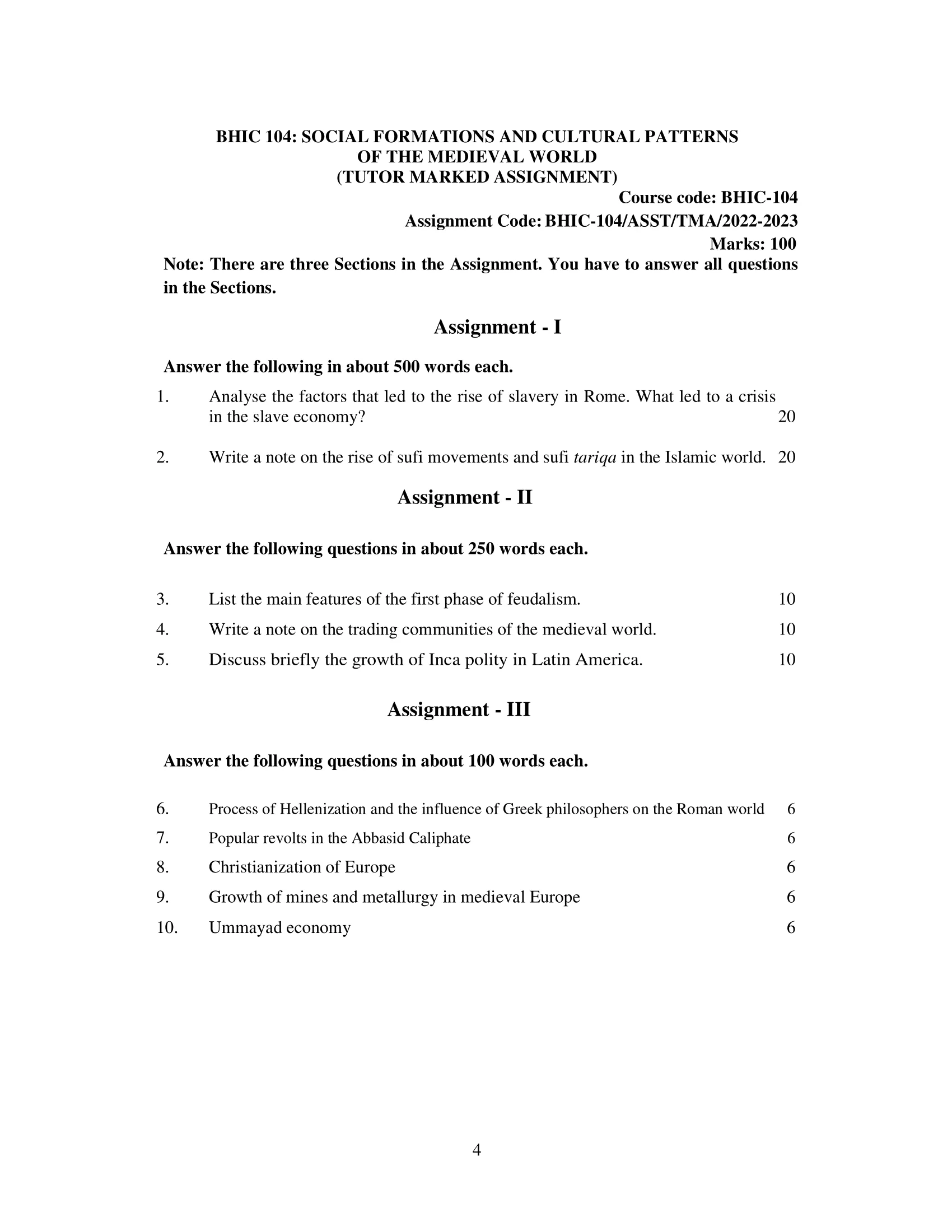Contents
- 1 Assignment – I
- 2 Answer the following in about 500 words each.
- 3 1. Analyse the factors that led to the rise of slavery in Rome. What led to a crisis in the slave economy?
- 4 2. Write a note on the rise of sufi movements and sufi tariqa in the Islamic world.
- 5 Assignment – II
- 6 Answer the following questions in about 250 words each.
- 7 3. List the main features of the first phase of feudalism.
- 8 4. Write a note on the trading communities of the medieval world.
- 9 5. Discuss briefly the growth of Inca polity in Latin America.
- 10 Assignment – III
- 11 Answer the following questions in about 100 words each.
- 12 6. Process of Hellenization and the influence of Greek philosophers on the Roman world
- 13 7. Popular revolts in the Abbasid Caliphate
- 14 8. Christianization of Europe
- 15 9. Growth of mines and metallurgy in medieval Europe
- 16 10. Ummayad economy

| Title | BHIC-104: IGNOU BAG Solved Assignment 2022-2023 |
| University | IGNOU |
| Degree | Bachelor Degree Programme |
| Course Code | BHIC-104 |
| Course Name | SOCIAL FORMATIONS AND CULTURAL PATTERNS OF THE MEDIEVAL WORLD |
| Programme Name | Bachelor of Arts (General) |
| Programme Code | BAG |
| Total Marks | 100 |
| Year | 2022-2023 |
| Language | English |
| Assignment Code | BHIC-104/ASST/TMA/2022-2023 |
| Last Date for Submission of Assignment: | For June Examination: 31st April For December Examination: 30th September |

Assignment – I
Answer the following in about 500 words each.
1. Analyse the factors that led to the rise of slavery in Rome. What led to a crisis in the slave economy?
Ans: The Roman Empire saw the rise of slavery as a major institution, and this was driven by several factors. One of the main factors was the growth of the Roman economy, which was based on agriculture, mining, and manufacturing. The increasing demand for labor in these industries led to the growth of slavery, as slaves were used to perform the work that was necessary to maintain the economy.
Another factor that contributed to the rise of slavery in Rome was the conquest of new territories. As the Roman Empire expanded, it encountered new populations who were taken as slaves and brought back to Rome. These slaves were used to perform a wide range of tasks, from manual labor to skilled work in industries such as weaving, pottery, and metalworking.
In addition, the growth of the Roman slave trade was also driven by the large number of prisoners of war who were taken during the empire’s military campaigns. These prisoners were often forced into slavery and sold to slave dealers, who in turn sold them to individuals and businesses throughout the empire.
However, the slave economy in Rome faced a crisis in the 2nd century CE, as the cost of acquiring and maintaining slaves became increasingly high. The growing number of slaves in the empire also created social and economic tensions, as slaves became a source of competition for jobs and resources. This led to a decline in the demand for slaves, and the slave trade became less profitable, which contributed to the crisis in the slave economy.
The crisis was further compounded by the increasing costs of maintaining a large slave population, as slaves required food, clothing, and housing. In addition, the growing number of slaves also led to the development of a large number of slave revolts, which threatened the stability of the empire.
2. Write a note on the rise of sufi movements and sufi tariqa in the Islamic world.
Ans: The rise of Sufi movements and Sufi Tariqa (Sufi orders) in the Islamic world took place during the 8th to the 14th centuries. Sufism is a mystical and ascetic dimension of Islam that emphasizes the pursuit of a personal connection with God through meditation, prayer, and other spiritual practices.
The rise of Sufism was a response to the growing formalism and legalism of mainstream Islam, as well as the influence of other mystical traditions such as Persian and Greek philosophy. Sufis sought to deepen their spiritual experiences and to seek a closer connection with God through direct personal experience, rather than relying solely on religious texts and institutions.
Sufi movements began to emerge during the 8th and 9th centuries, with the formation of the first Sufi orders. These orders were based on the teachings and practices of prominent Sufi figures, such as Hassan al-Basri, Rabi’a al-Adawiyya, and Al-Hallaj. These figures emphasized the importance of devotion, asceticism, and meditation in the pursuit of a closer connection with God.
Sufi orders were organized around a master-disciple relationship, with the master serving as a spiritual guide and mentor to the disciples. The master would pass on his teachings and practices to the disciples, who would in turn pass them on to their own disciples. Over time, these orders developed into well-established institutions, with their own rituals, practices, and structures.
The spread of Sufi orders was facilitated by the growth of trade and commerce in the Islamic world, as Sufi orders often had a strong presence in urban centers. This allowed them to attract a large number of followers and to establish themselves as powerful religious and social institutions.
The influence of Sufi orders reached its peak during the 12th and 13th centuries, when many of the great Sufi masters such as Jalaluddin Rumi and Abdul-Qadir Gilani emerged. These figures played a major role in the development of Sufi thought and practice, and their teachings continue to be widely studied and followed to this day.
Assignment – II
Answer the following questions in about 250 words each.
3. List the main features of the first phase of feudalism.
Ans: The first phase of feudalism, which took place between the 9th and 12th centuries in Europe, was characterized by the following main features:
- Manor System: The Manor System was the cornerstone of feudal society and provided the basis for the political and economic power of the nobility. Lords owned large estates, known as manors, which were self-sufficient communities that included farms, villages, and forests. Peasants lived on the manor and worked the land, while the lord provided protection and justice in exchange for their labor and a portion of their produce.
- Feudal Contracts: Feudal contracts, known as vassalage, were the key to the political and military power of the nobility. A lord would grant land to a vassal in exchange for military service and loyalty. The vassal would swear an oath of allegiance to the lord and was expected to fight for him in times of war.
- Warrior Aristocracy: The nobility of the first phase of feudalism were a warrior aristocracy, whose primary role was to fight in wars and maintain order. They were skilled horsemen and were often equipped with weapons and armor, making them the only class capable of defending the kingdom.
- Serfdom: Serfdom was the prevalent form of labor in the first phase of feudalism. Serfs were tied to the land and could not leave without the permission of the lord. They were required to perform labor services for the lord and pay him taxes, but were also entitled to a portion of the land for their own use.
- Local Autonomy: The feudal system was characterized by local autonomy, with lords having significant control over their own territories. They were responsible for maintaining order, dispensing justice, and providing for the needs of their tenants.
- Weak Central Authority: The central authority was weak in the first phase of feudalism, and lords often acted independently of the king. The king relied on the support of the nobility, and was often powerless to enforce his will on the lords.
- Decline of Trade and Cities: Trade and cities declined during the first phase of feudalism as the nobility became increasingly dominant. The lords were more interested in their own power and wealth than in the prosperity of the kingdom, and trade and commerce suffered as a result.
4. Write a note on the trading communities of the medieval world.
Ans: The medieval world was characterized by a vibrant and diverse trading system that connected various regions across Europe, Africa, Asia, and the Americas. Trading communities played a significant role in the growth of the economy and the spread of ideas, religion, and culture. Some of the main features of the trading communities of the medieval world are:
- Merchant Guilds: Merchant guilds were the primary organizations of the trading communities. These organizations provided protection, support, and regulation to traders and were instrumental in the growth of trade and commerce. They established standards for the quality of goods, regulated prices, and ensured the fair treatment of traders.
- International Trade: The medieval world was connected through a network of international trade routes that facilitated the exchange of goods and ideas. The Silk Road, which connected China to the West, was one of the most significant trade routes of the period. Other important routes included the Indian Ocean and the Trans-Saharan routes, which connected Africa with the Middle East and Asia.
- Urbanization: Trading communities were often associated with the growth of cities, which served as centers of trade and commerce. Cities such as Venice, Genoa, and Amsterdam in Europe, and Baghdad, Cairo, and Cordoba in the Islamic world, emerged as important centers of trade and commerce.
- Multi-ethnic Societies: Trading communities were often multi-ethnic and brought together people from different regions and cultures. This led to the growth of cosmopolitan societies that were characterized by religious, cultural, and linguistic diversity.
- Intercultural Exchange: The trading communities of the medieval world facilitated the exchange of goods, ideas, and cultures. This led to the growth of new ideas, artistic styles, and religious movements, and had a lasting impact on the development of the medieval world.
- Economic Growth: The growth of trade and commerce was a key factor in the economic expansion of the medieval world. Trading communities played a significant role in this growth, as they facilitated the exchange of goods, capital, and ideas, and helped to spur innovation and entrepreneurship.
5. Discuss briefly the growth of Inca polity in Latin America.
Ans: The Inca polity was a complex and highly organized state that dominated much of the Andean region in South America prior to the arrival of the Spanish conquistadors in the 16th century. The Incas developed a sophisticated system of administration and governance that allowed them to control a vast empire that stretched from present-day Ecuador to Chile.
The growth of the Inca polity can be traced back to the late 13th century when the Inca dynasty was founded by Manco Capac. Over the next several centuries, the Incas expanded their territories through a combination of military conquest and diplomacy, eventually creating a vast empire that encompassed millions of people.
The Inca state was characterized by a highly centralized administration, with the Inca emperor, or Sapa Inca, at the top of the political hierarchy. The empire was divided into provinces, each of which was governed by an appointed governor. The Incas also established a complex road network that connected the various parts of their empire and allowed for efficient communication and transportation.
In terms of economic organization, the Incas practiced a form of collective ownership known as the mita system, under which land and resources were managed by the state and distributed to individual households for use. The state also played a major role in agriculture and food production, with the goal of ensuring the food security of the empire.
The Incas also had a sophisticated system of record keeping, using knots on strings, known as quipus, to keep track of economic transactions and other important information. The Inca state was also characterized by its religious beliefs, with a pantheon of gods and a complex religious hierarchy centered around the Sapa Inca, who was considered to be the son of the sun god.
Assignment – III
Answer the following questions in about 100 words each.
6. Process of Hellenization and the influence of Greek philosophers on the Roman world
Ans: Hellenization was the process of spreading Greek culture, language, and ideals throughout the Mediterranean world, particularly in the eastern regions of the Roman Empire. It began with the conquests of Alexander the Great in the 4th century BCE and continued through the rise of the Roman Empire. Greek ideas and philosophies, particularly Stoicism and Epicureanism, greatly influenced Roman thought and intellectual life. Greek literature, art, and architecture were also embraced and imitated by the Romans. The process of Hellenization helped to create a common cultural identity and language throughout the Mediterranean world and laid the foundation for the development of a cosmopolitan culture in the Roman Empire.
7. Popular revolts in the Abbasid Caliphate
Ans: Popular revolts were a frequent occurrence in the Abbasid Caliphate, a Muslim empire that ruled over much of the Islamic world from the 8th to the 13th centuries. These revolts were often driven by various factors including economic hardship, political oppression, and religious discontent. One of the most notable revolts was the Zanj Rebellion, which took place in the 9th century and was led by enslaved black Africans in the region of modern-day Iraq. Other significant revolts included the Khurramiyyah movement, which was led by the charismatic religious figure Babak, and the Qarmatian movement, which was centered in present-day Bahrain and sought to establish a utopian society based on Islamic principles. These popular revolts challenged the authority of the Abbasid Caliphate and contributed to its eventual decline and fragmentation.
8. Christianization of Europe
Ans: The Christianization of Europe was a gradual process that took place from the 4th to the 15th centuries. It involved the spread of Christianity and the conversion of European peoples to the religion. The process was greatly influenced by the Roman Empire, which officially adopted Christianity as the state religion in the 4th century. The conversion of Europe was also facilitated by the work of missionaries and the establishment of monasteries, which served as centers of religious and cultural transmission. By the Middle Ages, Christianity had become the dominant religion in Europe and exerted a significant influence on European society, culture, and politics. The Christianization of Europe was a key factor in the formation of a unified European identity and the development of Western civilization.
9. Growth of mines and metallurgy in medieval Europe
Ans: The growth of mines and metallurgy in medieval Europe was a key factor in the economic and technological development of the region. The extraction of minerals and the production of metal goods increased dramatically during the Middle Ages, largely due to the increasing demand for these materials from the growing population and the expanding trade networks. The discovery and exploitation of new sources of minerals, such as silver mines in Germany and lead mines in England, helped to fuel this growth. The development of new technologies and techniques, such as the use of water-powered bellows in iron smelting and the introduction of the blast furnace, also helped to increase the production of metals. These advances had a profound impact on the economy and society of medieval Europe, stimulating trade and creating new industries, and laying the foundation for the technological revolution of the modern era.
10. Ummayad economy
Ans: The Umayyad economy was characterized by its size and diversity, as the Umayyad Caliphate controlled a vast empire stretching from Spain to India. The economy was driven by trade, agriculture, and the production of goods such as textiles, metal goods, and ceramics. The Umayyads established a sophisticated system of taxation and administration that facilitated the growth of the economy and provided the state with the resources to fund its military and administrative operations. The Umayyads also encouraged the growth of trade by providing support for merchants and promoting economic exchange between regions. The prosperity of the Umayyad economy attracted many immigrants and helped to create a cosmopolitan culture that was influenced by the various cultural traditions of the empire’s diverse populations.
How to Download BHIC-104 Solved Assignment?
You can download it from the www.edukar.in, they have a big database for all the IGNOU solved assignments.
Is the BHIC-104 Solved Assignment Free?
Yes this is absolutely free to download the solved assignment from www.edukar.in
What is the last submission date for BHIC-104 Solved Assignment?
For June Examination: 31st April, For December Examination: 30th October
















